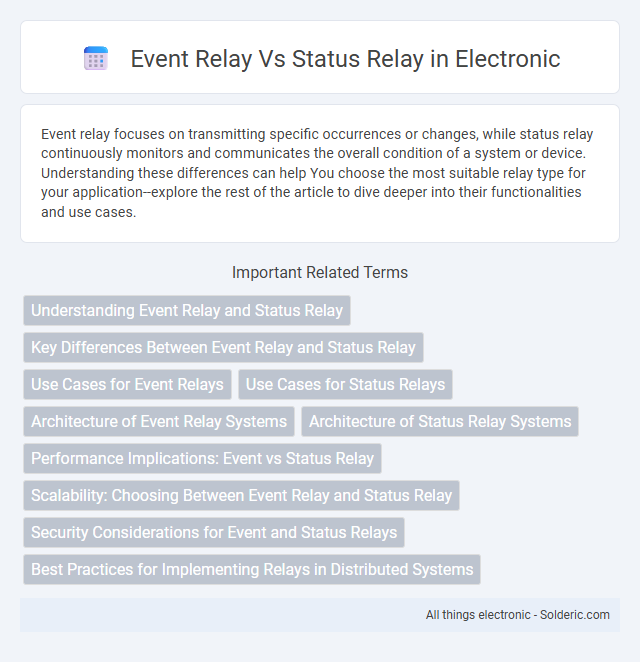Event relay focuses on transmitting specific occurrences or changes, while status relay continuously monitors and communicates the overall condition of a system or device. Understanding these differences can help You choose the most suitable relay type for your application--explore the rest of the article to dive deeper into their functionalities and use cases.
Comparison Table
| Feature | Event Relay | Status Relay |
|---|---|---|
| Definition | Transfers discrete event notifications as they occur. | Conveys continuous or updated status information. |
| Purpose | Notifies specific events or triggers in real-time. | Reports ongoing or current state data. |
| Data Type | Event-driven, often binary or timestamped data. | Status values, metrics, or condition indicators. |
| Use Cases | Alarms, alerts, and messages triggered by actions. | System health, operational states, performance metrics. |
| Update Frequency | Irregular, occurs only when events happen. | Regular or periodic updates. |
| Example | Door opened event, error alert triggered. | Current temperature reading, machine operational status. |
Understanding Event Relay and Status Relay
Event Relay transmits specific signals triggered by particular incidents or changes within a system, enabling real-time monitoring and rapid response to discrete occurrences. Status Relay continuously communicates the current operational state or condition of equipment, providing a constant update on system health and performance. Understanding the distinction helps optimize system diagnostics and control strategies by clearly separating event-driven alerts from ongoing status information.
Key Differences Between Event Relay and Status Relay
Event relays transmit discrete signals triggered by specific occurrences, ideal for applications requiring immediate response to changes or alarms. Status relays continuously monitor and display the operational condition of equipment, providing real-time status updates. The key differences lie in their function--event relays capture transient events, whereas status relays convey ongoing system states.
Use Cases for Event Relays
Event relays are primarily used in automation systems where real-time monitoring and immediate responses to specific triggers, such as security breaches or equipment malfunctions, are crucial. They enable rapid signaling to control panels or alert systems without waiting for status changes, ensuring prompt action in safety-critical applications. Industrial environments benefit from event relays for detecting transient events like short circuits or motor starts, facilitating efficient fault detection and operational control.
Use Cases for Status Relays
Status relays are primarily used in industrial automation and control systems to monitor and signal the operational state of machinery, ensuring real-time feedback and system safety. They provide reliable indications of equipment conditions such as overload, fault, or normal operation, enabling prompt responses to prevent damage or downtime. Common applications include motor control centers, HVAC systems, and power distribution panels where continuous status monitoring is critical for efficient management and maintenance.
Architecture of Event Relay Systems
Event relay systems utilize a distributed architecture that separates event generation from event processing, enabling scalable and real-time data transmission across multiple nodes. These systems rely on asynchronous communication protocols and event brokers to efficiently route and filter events based on predefined rules. By implementing event relay architecture, your applications can achieve decoupled components, improving responsiveness and fault tolerance compared to traditional status relay mechanisms.
Architecture of Status Relay Systems
Status relay systems feature a decentralized architecture where multiple input devices transmit discrete signals to a centralized controller, enabling real-time monitoring of equipment conditions. These systems use dedicated relay modules with predefined logic, ensuring rapid response times by directly reflecting the operational status without data interpretation delays. Integration of optocouplers and isolation components enhances signal integrity and protects sensitive control units within industrial automation environments.
Performance Implications: Event vs Status Relay
Event relay systems prioritize instantaneous transmission of discrete occurrences, minimizing latency to ensure swift response times in critical applications. Status relay mechanisms continuously monitor and update system conditions, which can introduce higher bandwidth demands and processing overhead due to frequent data polling. Performance optimization depends on balancing event-driven reactivity with the resource intensity of constant status updates to suit the specific operational environment.
Scalability: Choosing Between Event Relay and Status Relay
Event relay offers superior scalability by transmitting discrete events only when changes occur, reducing network traffic and processing load. Status relay continuously monitors and updates device states, which can become resource-intensive and less efficient as the system grows. Your choice should consider the scale of your network and the frequency of state changes to optimize performance and resource utilization.
Security Considerations for Event and Status Relays
Event relays transmit real-time alerts triggered by specific occurrences, requiring robust authentication and encryption to prevent unauthorized access and tampering. Status relays provide continuous monitoring data and must implement stringent access controls and integrity checks to ensure accurate and reliable system state reporting. Both relay types benefit from using secure communication protocols like TLS and enforcing role-based permissions to safeguard sensitive operational information.
Best Practices for Implementing Relays in Distributed Systems
Event relays efficiently propagate discrete signals triggered by specific occurrences, while status relays continuously monitor and communicate persistent system states. Best practices for implementing relays in distributed systems recommend using event relays for real-time alerts and minimizing network load, whereas status relays are ideal for health checks and system monitoring. You should design a hybrid approach that balances responsiveness with consistency, ensuring optimal system reliability and performance.
Event relay vs status relay Infographic

 solderic.com
solderic.com